
Please send all Checks and Money orders to :
Dave Taylor P.O. Box 87 Sylvania, OH 43560
419-842-1863
Click Here to E-mail Us!

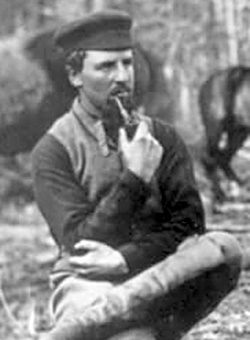
14 10
~~~~~~~~~~~
LAYAWAYS ARE WELCOME:
Need to split your order into multiple payments? No problem! A simple 20% earnest money deposit will hold your item for you.
You can then pay it off in easy installments that fit your budget.
~~~~~~~~~~

14-10-01 … Superb Near Mint, Inscribed 45th Ohio, Kentucky Carried, 1851 Colt Navy Revolver:
Without question
THE BEST
condition inscribed Colt Navy I have ever owned. Truly magnificent. NRA “Excellent” approaching mint. Far far better than “Extra Fine”. 90% blue, 90% case color, 100% scene, all matched serial numbers. Stellar! The back strap is professionally inscribed
“To Major Hill 45th Regt. O.V.I.”
The owner has a most interesting biography. He is Joseph Hill Jr. Born 1824 in Concord, Ohio. In the mid 1850s Governor Salmon P. Chase appointed Hill to his staff as Colonel, where he worked to strengthen and improve the Ohio Militia. When the war broke out he asked for a major’s position in the 66th Ohio but that position was already filled. In the Spring of 1862 he was offered the Major’s position in the 45th Ohio which he accepted. Shortly thereafter he was presented with this revolver bearing SN 127080 (1862 production). With his regiment they moved to Kentucky to defend against Confederate General Kirby Smith. On November 16th Hill was promoted to Lieut. Colonel of the regiment. On December 2nd Hill was ordered by General Gillmore to take four companies of the 45th and two mountain howitzers to Versailes, Kentucky to guard the Kentucky River. The regiment lost five men captured. In early 1863 they engaged CS Colonel Cluke, and in March they became a mounted regiment brigaded with the 7th Ohio Cavalry and 10th Kentucky Cavalry. On March 30th 1863 Hill and his men went into action at Dutton’s Hill, KY., It was a hard little fight with Confederate cavalry under General John Pegram, who later saw service commanding infantry under Lee in Virginia. Pegram led a brigade of roughly 1,500 cavalry with some mountain howitzers on a raid across the Cumberland River to gather cattle in Kentucky. The 45th Ohio (now mounted) was part of a brigade commanded by Gen. Quincy Gilmore sent out to counter Pegram. Gilmore’s troops were a combination of cavalry, mounted infantry, and few artillery pieces. He found Pegram’s men posted on Dutton’s Hill, three miles north of Somerset, covering the withdrawal of the cattle they had gathered across the Cumberland River. Pegram attempted to outflank Gilmore’s right, but the movement stalled and Gilmore in the meantime bombarded the Confederate positions on the hill and then sent the 7th and 45th Ohio forward in a dismounted charge that took the hill after hard fighting with the 2nd Tennessee, 1st Florida and 1st Louisiana, and hit the Confederate flanking force in the rear and forcing Pegram to withdraw. Confederate losses were reckoned at close to 200 and Federals boasted they lost fewer than thirty. The 45th Ohio lost one man killed and another wounded. The skirmish was a Union victory that pushed the rebs back to the Cumberland River.
Within a few weeks, learning of pressing matters requiring his personal attention at home, Hill tendered his resignation for personal reasons and despite the pleadings of his Colonel to remain with the regiment, and despite General Schofield’s concurrence with the Colonel, General Burnside nonetheless granted his request and Hill returned to Ohio to attend to family and business matters. The Colonel of the 45th wrote…
“ I know of no person who can fill Lieut. Colonel Hill’s place, and I part with his services with regret.”
The revolver is truly magnificent. You will note the number “2” stamped as a suffix near the serial number on the barrel lug, trigger guard, frame, and butt strap. This likely indicates the revolver was part of a pair ordered from the Colt factory. Because of the stellar condition I hypothesize that this Colt was likely part of a cased set… a brace of Navies if you will. I would further submit that some family members in modern times split the guns up to satisfy equality in settling a will upon a descendant’s death. I can’t prove it, but I believe it to be likely. In other words, there may be a matched twin to the Colt in someone’s possession. The condition of this wonderful specimen would certainly warrant marrying it with a fine condition original casing with accoutrements. Or it is beautiful displayed just as it stands
… $18,500.00
Click Here to E-mail Us!
Call us @ 419-842-1863
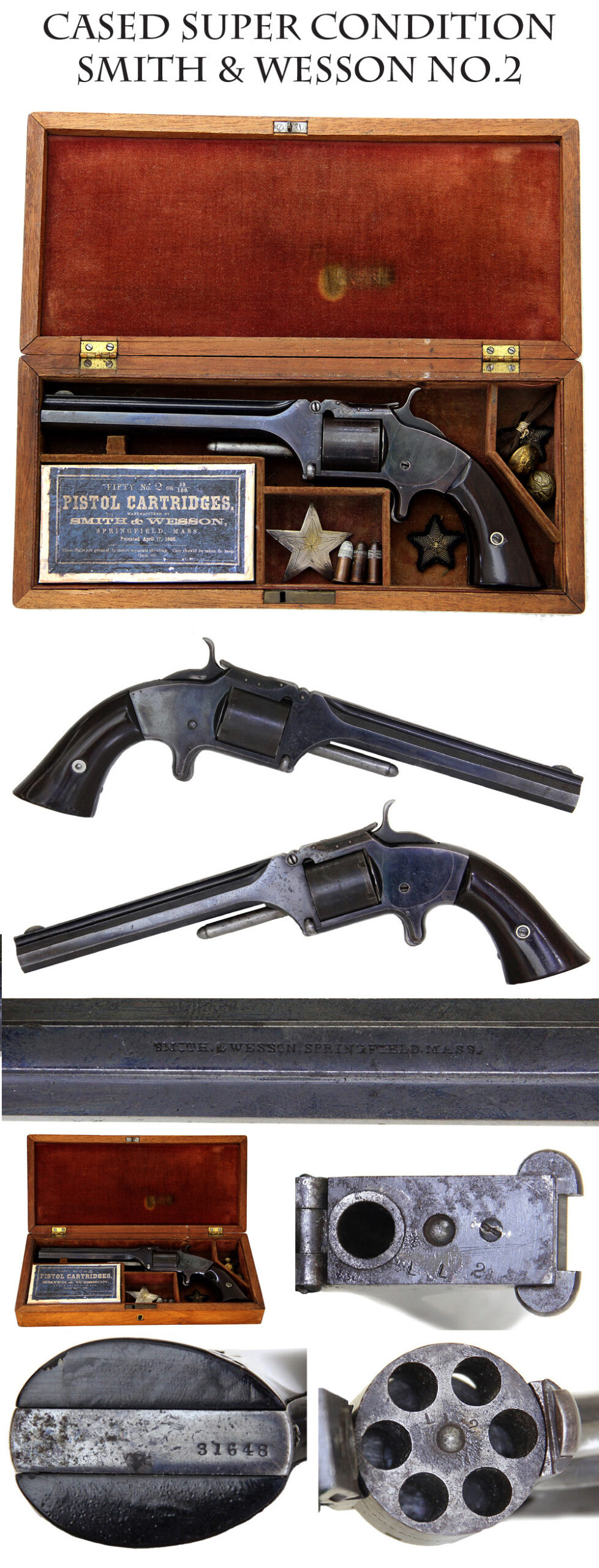
14-10-02 … Superb Condition Cased Smith & Wesson No. 2:
Excellent to near mint Condition. “Minty” in the current vernacular. The six-shot .32 caliber S&W was widely carried by officers during the Civil War. The rimfire cartridges were waterproof and hard to damage. Here is a remarkable example in the original Smith & Wesson factory casing. 100% original and mechanically as new. Excellent rosewood grips. About 95 percent high luster factory blue overall, with just a smidge of thinning and wear on high areas. Has vivid Smith & Wesson, Springfield, Mass. barrel legend on top of the barrel. Cylinder face and face of barrel lug have matching bench marks, “LL2”, butt strap shows serial number 31648, which is a solid wartime serial number. (Anything under 36,000 is pre April 1865.) When found it did not have any cartridges. In my personal collection I have a presentation cased pair with an unopened box of cartridges. I had my photographer Arthur make a facsimile package using my original box, and have included it here. Looks like the real McCoy. Also displayed in the box are some original .32 caliber cartridges, a silver star of unknown purpose with five attaching wires on the back, and some Civil War eagle buttons. The casing is in excellent condition, lightly faded red velvet lined pad under the lid with one wear spot and velvet covered bottom with wood dividers. There is a hairline crack in the lid. A magnificent looking set that would be fun and not too hard to complete with original cartridges, oiler, cleaning jag… etc. Looks great just the way it stands
… $5,250.00
Click Here to E-mail Us!
Call us @ 419-842-1863

14-10-03 … Confederate Officer’s Sword by Haimann …
Confederate Haiman Foot Officer’s Sword. Louis and Elijah Haiman of Columbus, Georgia, made a lot of army equipment for the Confederacy: from buckles and tents to swords. Their factory eventually covered a city block and employed five hundred people. Their edged weapons included both cavalry sabers and officers’ swords. Haiman was the most prolific of ALL Confederate makers. In fact Haiman produced more cavalry sabers than Ames! Here is a nice example of their work for an infantry line officer. Characteristic broad flattened oval pommel made without decoration, simple knuckle guard and counter guard pierced with floral designs like the Federal 1850 foot officer’s sword, single edged blade with single broad fuller that is unstopped at the ricasso. See Albaugh’s Photographic Supplement, page 93, and his Addendum, page 30-31, for some nice parallels. The blade is exceptionally clean, showing a mixed silvery-gray with some darker gray spots and areas. No notable, nicks, scaling or damage. I had the grip wrap and wire professionally restored last month, and it is so well done you would be hard pressed to know it is a restoration. A very nice undisturbed patina to the brass. No sign of the blade having been etched. This is the typical sword for an infantry lieutenant or captain serving in the Confederate army during the Civil War. A very representative example
… $2,350.00 SOLD
Click Here to E-mail Us!
Call us @ 419-842-1863
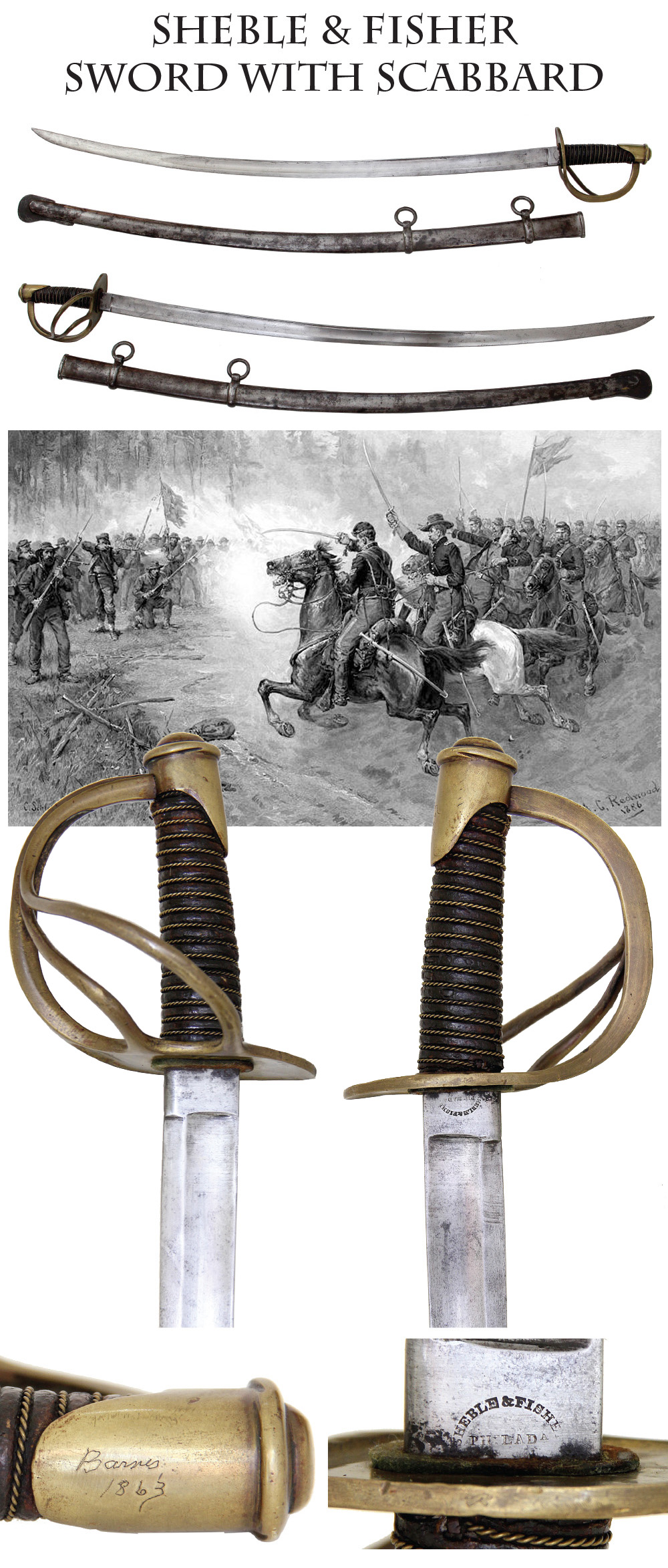
14-10-04 … Sheble & Fisher Sword and Scabbard …
Sheble and Fisher 1840 Pattern Heavy Cavalry Saber Thilman rates the 1840 pattern saber produced by Sheble and Fisher as scarce. No military contract information has survived, but some light artillery sabers made by the firm are dated and inspected, and similar cavalry sabers made by Hammond, also of Philadelphia, show up later in government arsenals also without any surviving contract information. The Sheble and Fishers also show up in enough numbers to indicate the company may at least have been expecting a contract and everyone agrees that they were used. This has a clear “Sheble & Fisher” mark in an arc over “Philada.” at the ricasso. Full grip leather and wire with just some rubbing at the high points of the leather. Mellow, but not dark, patina to the brass. Blade washer in place below the guard. Blade is smooth and silvery gray with some traces of the cross polishing above the ricasso, no nicks or damage. Scabbard is complete with rings and throat, originally bright, now mixed silver-gray and brown. Crudely scratched in on the face of the pommel cap is the name “Barnes” and the date “1863.” This is a nice tie in with their business listing that year, which was the only time they included sabers in the list of products made by the company. Tracing the name down in cavalry units is likely to produce a number of candidates, but might pay off in narrowing down the list of potential regiments who received these weapons. In any case, this is a significant sword in that the inscription shows they were issued and carried by that year. A nice untouched look and a scarce saber … nocode
… $795.00 SOLD
Click Here to E-mail Us!
Call us @ 419-842-1863

14-10-05 … Whitney 1861 Navy Rifle: the Whitneyville-Plymouth Rifle and Bayonet …
These .69 caliber rifles were developed in the 1850s by USN Captain John Dahlgren, who had an interest in ordnance. The “Plymouth” nickname derives from his ship, on board which he tested new weapons. Ours is one of the wartime production of 10,000 contracted for by Whitney in 1861, and completed in 1864. Good wood and decent metal, with a nice first style lockplate with a very clear 1863 date at the rear, U.S. over Whitneyville forward of the hammer and a dynamic Whitney eagle with shield and flag between. Whitney used the 1861 rifle musket pattern lock, but with no cleanout screw on the bolster. He also used some residual parts from other contracts, resulting in some variations, but ours follows the standard pattern with a finger spur at rear of the triggerguard. Very clear FCW (Frank C. Warner) inspector cartouche on the offside. Bayonet lug in place, characteristic special pattern long range rear sight, both bands swivels and original special pattern ramrod. Wood is good, with some minor handling marks and dings, one narrow gouge line running a couple inches forward on the offside from the forward lock screw, minor dings and digs at the wrist and breechplug tang from use. Nipple shows some battering and corrosion from actual firing and the wood some slight burn marks from percussion caps below the hammer. Metal is generally gray, smooth, with some darker areas near the breech. Mechanics are fine. Buttplate matches in color. Bench number 2237 on the breechplug tang. These were meant to match the bayonet numbers when fitted at the factory, but were probably separated the moment the crate was opened on board ship. With this is the correct Collins made brass-hilted saber bayonet (they could also take the Dahlgren Bowie bayonet.) Medium patina to the brass, clear blade markings at ricasso reading “Collins & Co. / Hartford Conn.” And numbered on hilt 5845. Good blade, single edged with false back edge, slight yataghan style curve, silver-gray with darker gray spots, no nicks. A very interesting weapon is US small arms design and a key piece in a Navy collection as well. (I also have a Bowie Bayonet if you want one.) … no-code
… $2,750.00 SOLD
Click Here to E-mail Us!
Call us @ 419-842-1863
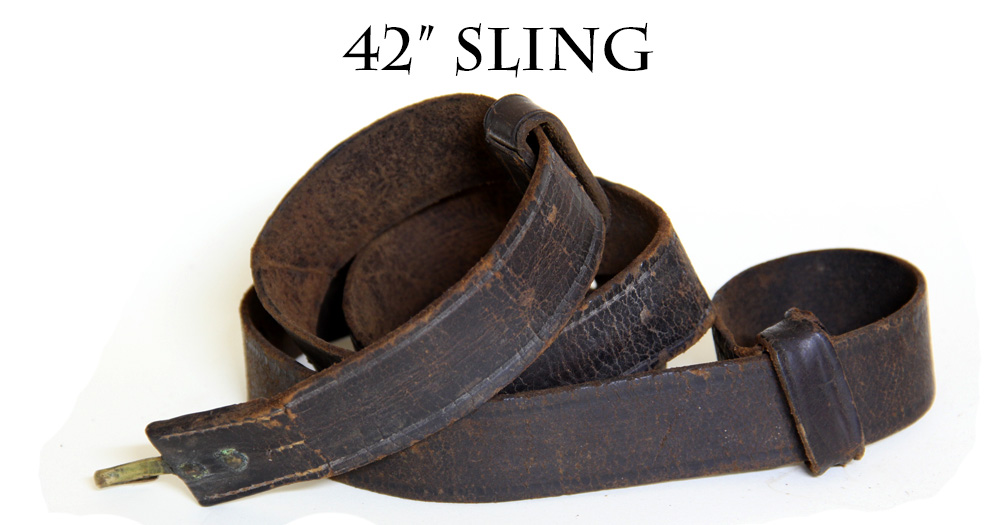
14-10-06 … Very Fine CW Musket Sling:
Regulation issue sling for the Springfield and contract muskets, roughly 1″ wide … and about 42″ in length. Complete with brass hook, sewn loop end, and sliding loop keeper. Fine to excellent condition with good life and superb finish. No maker’s mark present. Just some storage dirt that will clean easily. A very nice example
… $325.00 SOLD
Click Here to E-mail Us!
Call us @ 419-842-1863
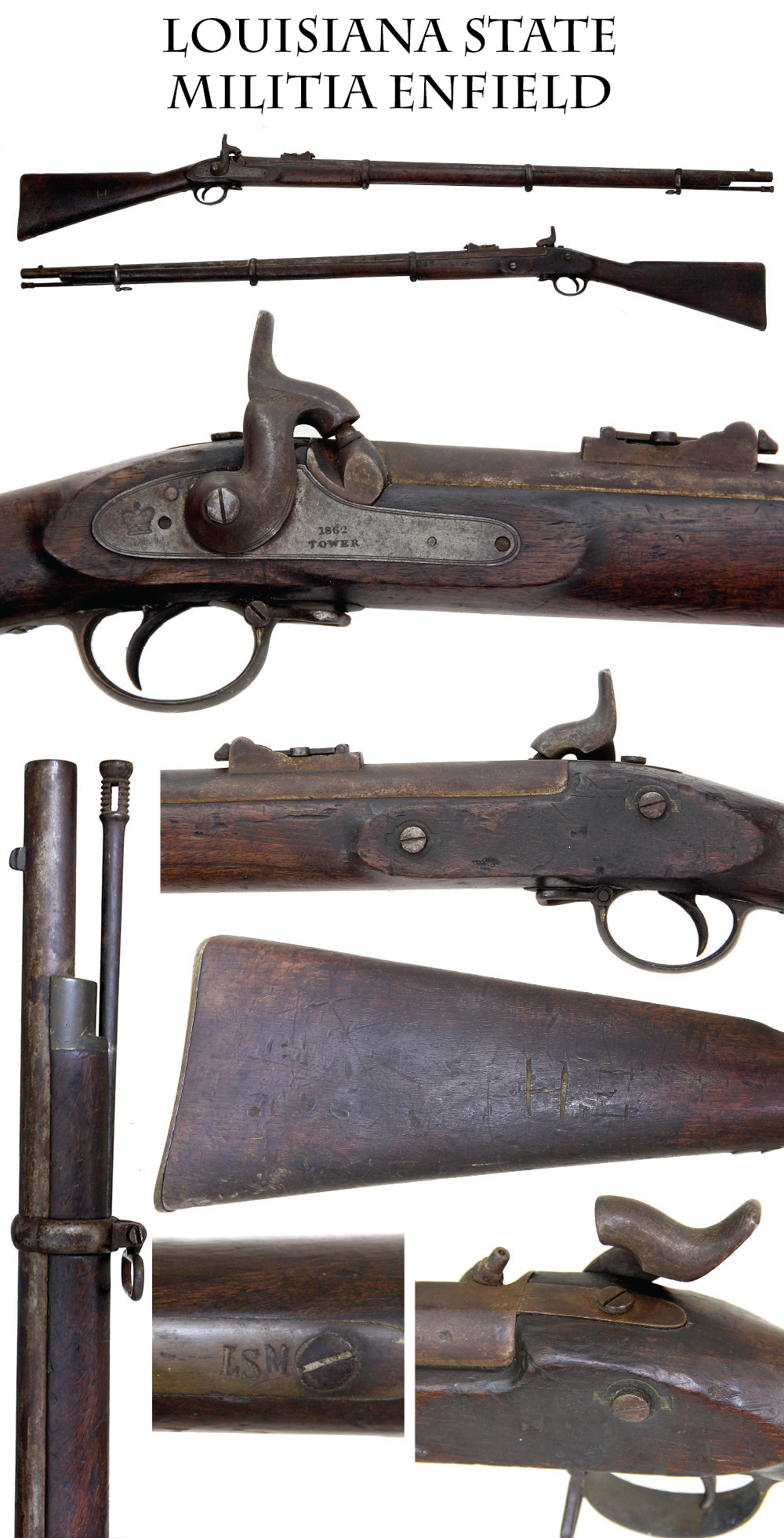
14-10-07 … 1862 Dated Tower Enfield …
Civil War 1862 Dated P-53 Enfield Marked for Use by the Louisiana State Militia ex CSA Used! Attic condition untouched P53 Enfield Rifle Musket. Imported and issued by both sides in large quantities, second only to the various Springfield patterns, long viewed by collectors as the typical Confederate longarm. Handling marks and dings to the wood, but essentially an attic condition gun that has been untouched for over a hundred years. Very clear 1862 over Tower marking forward of the hammer and crown to the rear. Barrel markings at breech are about worn away. 100% original and complete. Thin light brown surface patina with bright metal peeking up from underneath. Wood has some handling marks and dings but shows remarkably sharp edges around the lock, though with one long chip out just under the hammer. Initials “HE” carved into the right side of the butt flat and possibly lightly scratched further to the rear. Metal very good at the breech, nipple not battered, wood to metal tight. Deeply stamped in the brass triggerguard tang are the initials “LSM” next to the tang screw. This is the Louisiana State Militia, regiments of which were formed as early as 1864 in Federal held portions of the state and which continued to serve during reconstruction, regiments consisting of Black and a few White residents of the state. Of note, the vast majority of LSM Enfields are captured Confederate guns, and this one has all the earmarks in terms of wear from wartime use. With an 1862 date, the gun undoubtedly had wartime service in the field, was captured, and was then issued to the Black Federal troops. The whole reconstruction period is a complicated and fascinating one. This is an especially interesting gun with the history involved in the LSM marking
… $2,350.00 SOLD
Click Here to E-mail Us!
Call us @ 419-842-1863
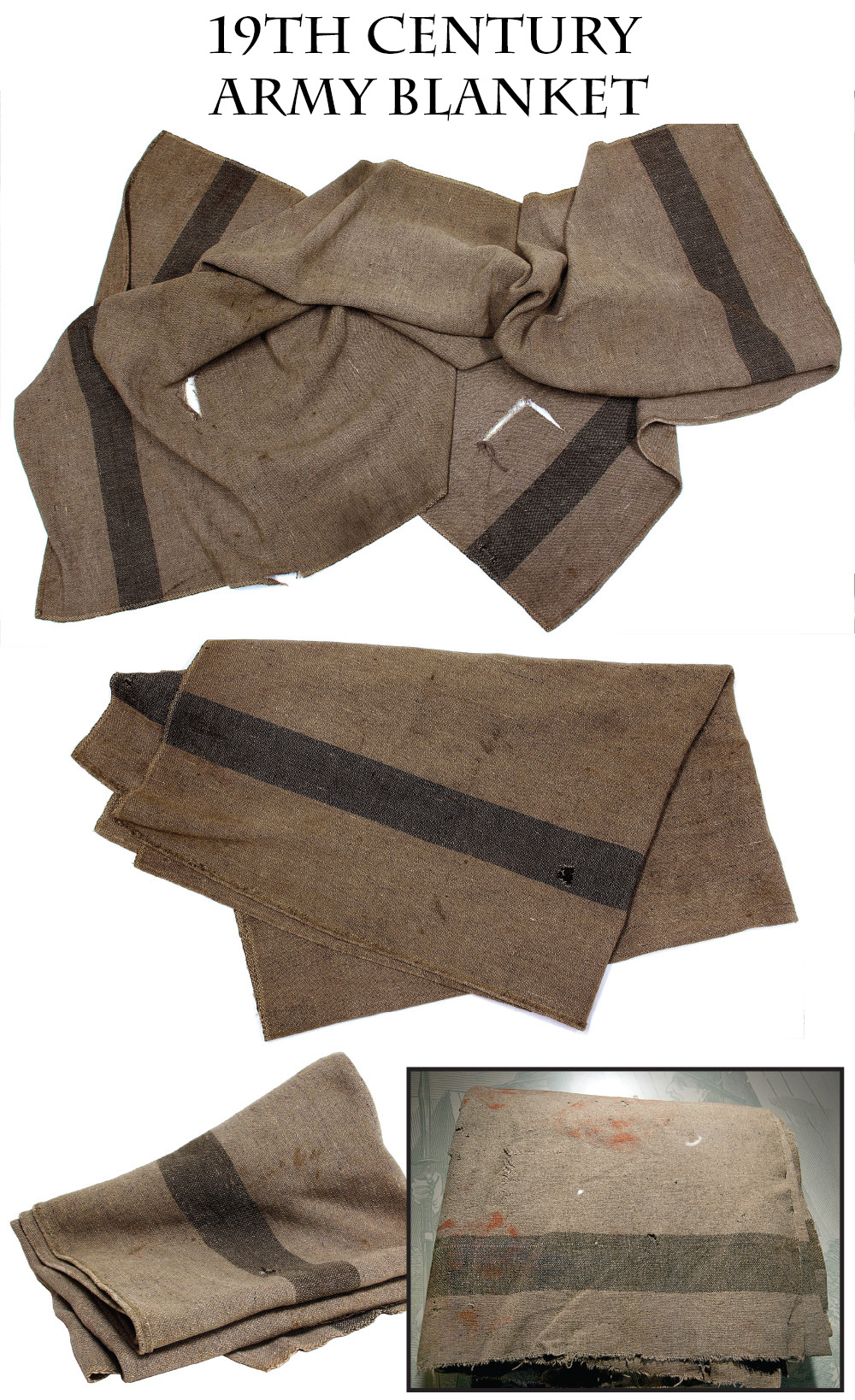
14-10-08 … Antique Military Blanket …
Measuring about 54″ x 70″ this blanket is typical of ones used by the U.S. Army late in the 19th century. In my opinion this blanket dates 1880s to 1900 era. The stripes are woven into the blanket, it has no “US” stitched into the center area as seen on the Holy Grails of 1860s army blankets. Has a couple of notable tears easily visible in the top image, and shows much age and use. A great display item to roll up on the top of a knapsack at a fraction the cost of a Civil War issue example
… $150.00 SOLD
Click Here to E-mail Us!
Call us @ 419-842-1863

14-10-09 … French Flintlock Pistol …
Napoleonic 1813 Dated French m1804 (An XIII) Cavalry Pistol … A real First Empire cavalry pistol of Napoleon I. The 1804 pattern was based on several earlier patterns, going back to the 1786 navy pistol, and was produced in large numbers mostly from 1806 to 1814 to arm the Emperor’s cavalry, each trooper carrying two in his pommel holsters. (The “An XIII,” or “Year 13” designation was derived from the new calendar adopted during the French Revolution.) Ours is not only clearly marked on the lockplate “Maubeuge / Manuf Imple” (The Imperial Factory at Maubeuge), along with numerous small inspector numbers and letter, but bears cartouches in the wood opposite the lock clearly dating it to 1813. The pistol is in remarkable condition for its age, with functioning mechanics, smooth metal with gray overlaid with some brown on the barrel, light gray and darker gray mixed on the lockplate, hammer and frizzen. Mellow patina to the brass barrel band, side plate, triggerguard, butt cap and flash pan. Nice edges to the wood, good color and only minor handling marks. Missing just the short ramrod, which could be replaced with an accurate reproduction until a real one comes along. A really nice and historic cavalry pistol perfect for War of 1812 or Waterloo display … gej
… $1,450.00 SOLD
Click Here to E-mail Us!
Call us @ 419-842-1863

Artillery Fuse Packs …
Timing shells to burst over their targets required fine judgment and calculation on the part of artillerymen and a number of different patent fuse systems were tried. Here is a selection of fuse packs containing fuses of different burning times that a gunner would select and then cut if necessary for a more exact timing of detonation. Needless to say, this called for steady nerves when opposing artillery is firing back at you. The packs hold five fuses each in paper covered drilled wood blocks fitted with a cloth tape to open them by tearing the paper. Each bears a printed Frankford Arsenal manufacturing label on color coded paper to make it easier for a gunner to pick the right pack. These used to be available in quantity from the old surplus dealers who bought them at government auctions or got them second-hand from Bannerman and the like. They are not common anymore. I offer several of different time designations, all with clear date, Frankford, and timing information. These are key to an artillery collection, but display very nicely in any Civil War collection because of the color and labeling. All are very displayable …
NOTE: EACH PACK IS WRAPPED IN PLASTIC “SHRINK-WRAP” WHICH DISTORTS THE LABELS APPEARANCE IN THESE JPG PHOTOS. THE ACTUAL LABELS ARE CLEAR AND LEGIBLE.
14-10-10 (A) … 4 Second fuses …
excellent cond
… $110.00
SOLD
14-10-11 (B) … 5 Second fuses …
excellent cond one tiny tear in bottom
… $110.00 SOLD
14-10-12 (C)… 5 Second fuses …
VG condition small loss of paper on bottom
… $95.00
14-10-13 (D) … 8 Second fuses …
excellent cond with one small tear on bottom
… $100.00 SOLD
14-10-14 (E)… 8 Second fuses …
excellent cond with one small tear on bottom
… $100.00 SOLD
14-10-15 (F)… 15 Second fuses …
VG condition with small loss of label at top
… $100.00 SOLD
14-10-16 (G) … 15 Second fuses …
VG with small loss of label at top
… $100.00
Click Here to E-mail Us!
Call us @ 419-842-1863
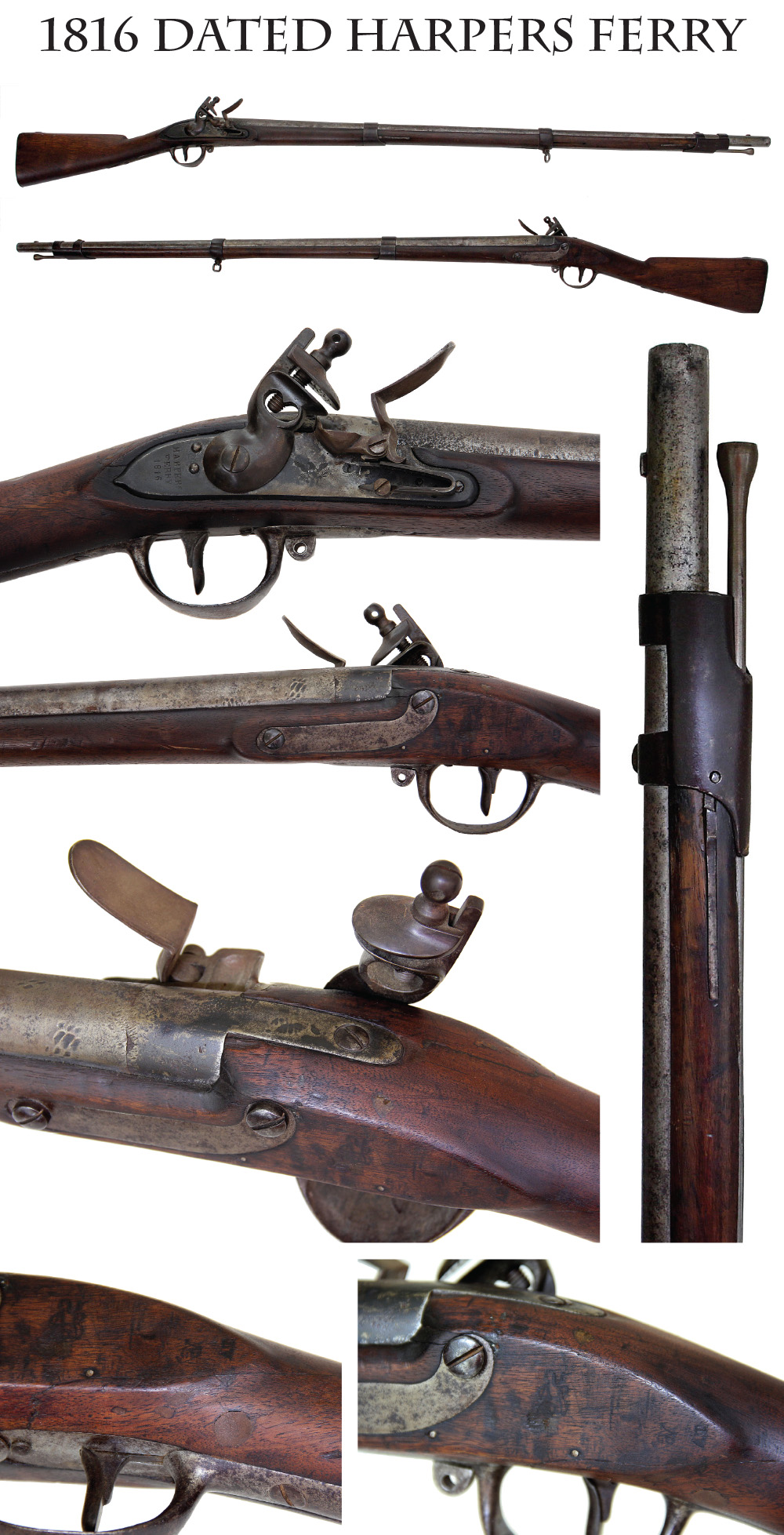
14-10-17 … 1816 Dated Harpers Ferry …
1816 Harpers Ferry Lock on this Reconverted Musket: This gun was so cheap I had to buy it! Whether you want one to hang on the wall or use in reenacting… here you go. The stock is full length and shows ink cartouches and stamps on the left side. There was some repair made to the wood just aft of the triggerguard on the offside – I see three plugs of wood filler on the bottom of the wrist and a small one at the top. The general configuration of the gun is that of a 1795/08 musket. The barrel has a separate breech and breechplug showing that it was converted to percussion, likely for use in the Civil War. After it passed its working life, however, someone decided to return it to its flint configuration and found an 1816 dated Harpers Ferry lock to fit it. Aside from the plugs, the wood is not bad. The lock apron shows pretty sharp edges as does the reverse, along with some ink and stamped cartouches. There are the usual small handling dings and discolorations, but nothing too bad. The barrel is gray overall with dark spots, some minor corrosion and a couple of vice marks near the breech. The bands are darker. The lock plate shows some mottled color and the brass pan has a dark patina. The Harpers Ferry 1816 stamp behind the hammer and the eagle forward of it are strong. The front sight is in place. The upper swivel is there. The lower swivel is missing but the lug is present. The ramrod is a reproduction rod for a ’63 Springfield that should be changed out if you are going to hang it up. A bargain at
… $735.00 SOLD
Click Here to E-mail Us!
Call us @ 419-842-1863

14-10-19 … Kittredge Cartridge Box on the Original Belt for Henry Rifle and Wesson Carbine:
These brass cartridge boxes were actually designed and patented by Augustus Bennett, but are far better known as Kittredge Boxes from their sale and marking by that famous Cincinnati gun dealer. Designed to hold loose ammunition, the brass box and lid were waterproof, had two belt loops on the back and a spring arrangement that made sure the cover would snap into place once lowered and the wearer would not have to fumble around with a latch tab. This one has a nice undisturbed patina and even comes on a wonderful 1860s commercial leather gun belt with a tooled edge and long billet to fasten into a roller buckle mounted on the other end with a protective safe beneath it. The box is prominently marked on the cover: “B. KITTREDGE & Co. / GUN DEALERS/ CIN OHIO / PATENTED. JAN.27.1863/ REISSUED APL.14.63” The top line is a tad rubbed in the middle, but can be made out, the other stamps are sharp and clear. Measuring 4 1/4 inches wide, 3 1/2 inches long and 1 1/2 inches thick, these boxes were sold by Kittredge along with Wesson rifles and Henry Rifles that used fixed metallic ammunition. These are considered by modern collectors to be a Henry Rifle accessory. Ours has a nice “out of the attic” and unmessed with look, particularly on its leather waist belt. One original cartridge comes with it to fill out the display. A very sought after accouterment and a nice piece!
… $1,250.00 SOLD
Click Here to E-mail Us!
Call us @ 419-842-1863
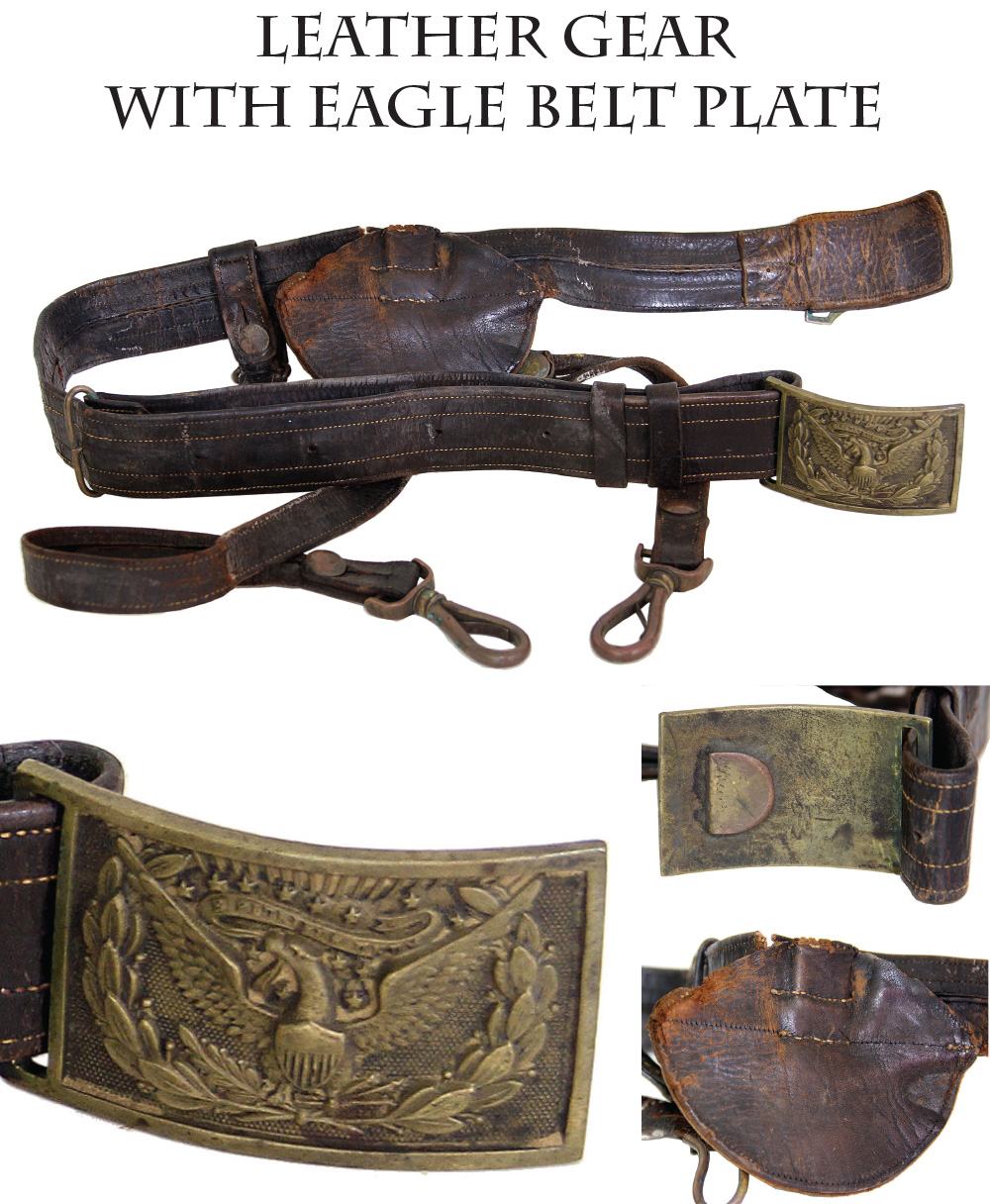
14-10-20 … Civil War Union Officer’s Sword Belt …
It’s nice to find these with any kind of condition. Officers had to purchase their own gear and commercial firms supplied them with very high grade leather, as this one is. This is the classic officer’s belt rig: thin leather folded over a canvas core and stitched together with four parallel rows of stitching visible on the exterior of the belt. The belt plate hasp, or keeper, is stitched at one end with a leather piece extending from it to protect the uniform when the belt is fastened. At the other end the belt loops through the side slot of a regulation 1851 pattern rectangular eagle belt plate and is adjusted for size by a small brass oval loop buckle with a small tongue. Two leather tightening slides keep the belt tight. The shorter forward saber sling on the left side is stitched in place with a large semicircular safe stitched behind it to protect the uniform when the sword is carried on the carrying hook at waist height. The longer rear sling slides along the belt freely on its own loop. Both slings terminate in brass swivel clips that enable a sword to be mounted or taken off quickly. The plate (buckle) is the regulation officer’s plate with the wreath cast integrally to the plate, but with the design done in better die work than the enlisted plates. The tongue on the reverse is what collectors call the middle-width variety. Some attempt to date plates to the early, middle or late war by the width of the tongue, but in fact the width seems to be the result of variations among the many makers supplying the military goods dealers who in turn supplied the officers. This plate shows crisp detail with just some minor dirt in recesses. Only very minor wear or abrasion to the leather. A very nice example
… $950.00 SOLD
Click Here to E-mail Us!
Call us @ 419-842-1863

14-10-21 … Another 1851 Pattern Civil War Officer’s Sword Belt …
Everything I said about the other officer’s belt offered on this list goes for this one. This one is similar to the other offered but shows some differences, as would be expected with scores of different makers and hundreds of dealers. The same basic design holds: a thin leather is folded over a canvas core and stitched together. In this case the stitching is a fairly simple stitch running along the top and bottom edges. The long rear sword sling moves freely on its loop. Both slings are intact and retain their snap hooks. The shorter forward sling is stitched in place over a brass loop that also supports the carrying hook, and a semicircular safe is stitched behind it with a small horizontal slot to allow movement of the sling and hook. The plate is the same style officer’s plate with the wreath cast integrally to the plate design rather than being a separately applied wreath of German silver sweated to an open spot on the plate. The tongue is the common middle width style, and the keeper, hasp, bench marked “306 Y” I don’t see a number on the plate, but it may be concealed on the side bar. Minor rubbing and abrasion to the leather here and there, but nothing too bad and a solid piece. Excellent for display with an officer’s sword or frock coat. One friend of mine has one draped over a camp chair in his front hall, looking like an officer just stopped by and left it in the entry way on his way in the door
… $950.00
Click Here to E-mail Us!
Call us @ 419-842-1863
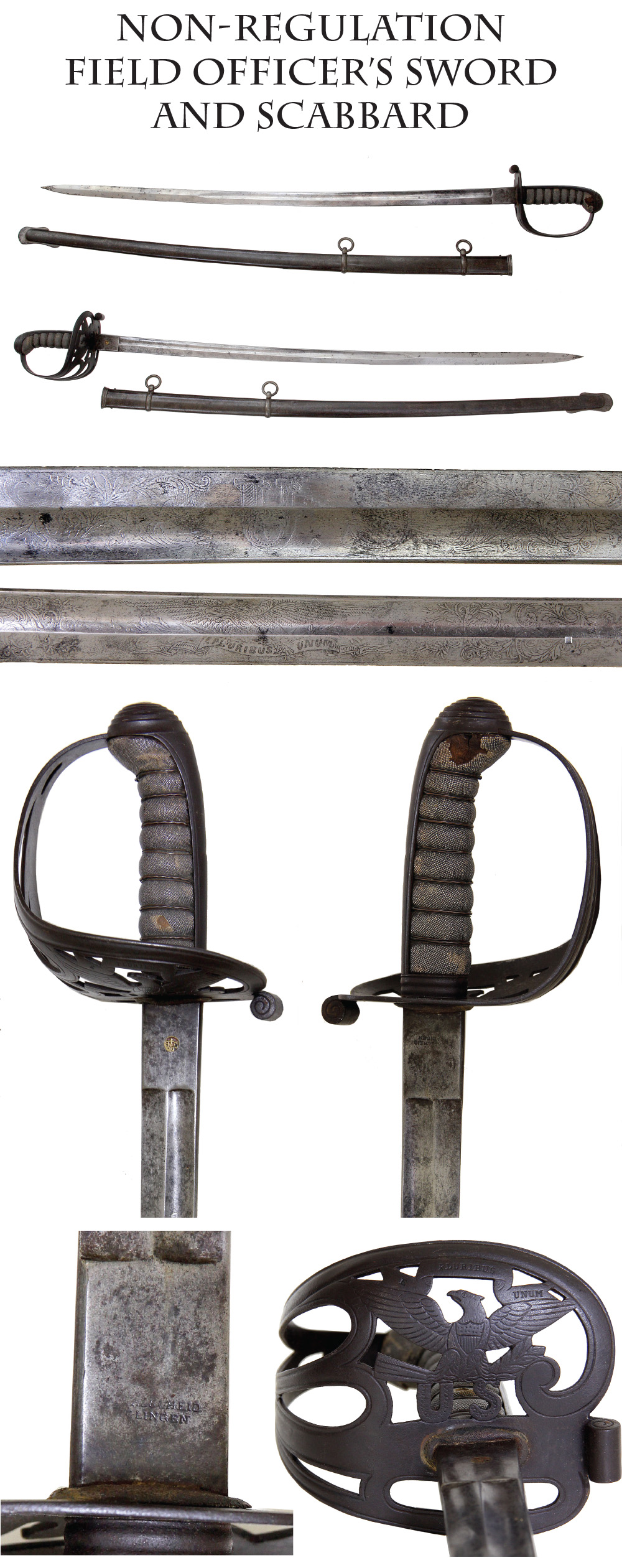
14-10-22 … The “Peterson-75” Civil War Officer’s Sword 14-10-22 …
Nicknamed from its listing in Harold Peterson’s famous book, The American Sword, is this pattern of non-regulation officer’s sword that was popular for field use because of its metal scabbard. These were German made but patterned on the British 1822 pattern sword and incorporated a US eagle and national motto worked into the steel guard, along with several different styles of blade etching. Ours is clearly marked by Walscheid Solingen on one side of the ricasso, and on the other with an inset stamped brass disk reading “proved.” The hilt is mounted in steel with a grooved round pommel and slotted knuckle guard that leads to the counter guard with eagle and E PLURIBUS UNUM in ribband motif and curled quillon. The grip is rayskin with triple wire (thin, coiled, thin), back strap, and ferrule at the base.
The blade is single edged, spear point with substantial back edge, single fuller running about 2/3 of the blade, no nicks, silvery-gray with grayer dark areas, but very legible etching: and spread winged eagle with ribband and motto on one side and a large cross-hatched US on the other, both surrounded with profuse floral motifs. The scabbard is equally nice, both carrying rings, drag and throat in place, mellow aged color a smoky pewter with some shades of purple and blue. Very minor wear to the rayskin of the grip. A very nice sword. Typical of those carried in the field by officers who did not want to explain to a presentation committee how their costly gift got banged up in the fighting or be troubled by a leather scabbard broken in action while they were brandishing the sword to keep the men in line. A most affordable CW officer’s sword
… $835.00
Click Here to E-mail Us!
Call us @ 419-842-1863
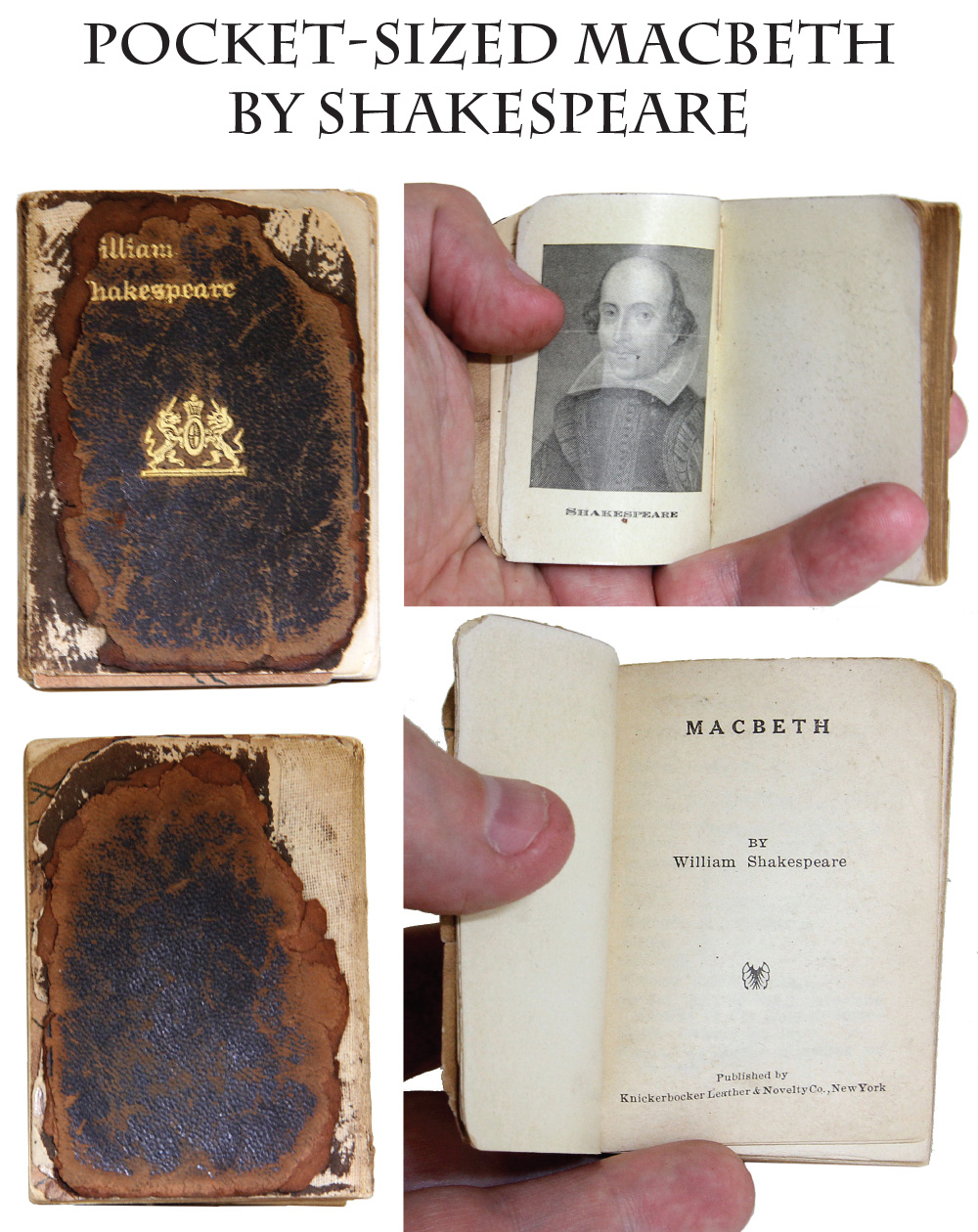
14-10-23 … Pocket sized Shakespeare …
These miniature editions were published by the Knickerbocker Leather & Novelty Company in New York in the late 1800s and early 1900s and sold in little boxed cases as portable libraries. This one is their edition of Macbeth, with a very worn leather cover and would make a suitable go-with in a display of late 19th/early 20th century soldier s personal effects. My helper Tom sits on the porch smoking a pipe and reading this to impress the neighbors, but that is another matter. I think he had a copy in World War One
… $10.00 SOLD
Click Here to E-mail Us!
Call us @ 419-842-1863

14-10-24 … Identified 9th Illinois Cavalry Civil War Soldier s 1863 Dated New Testament …
Very interesting pocket size copy of the New Testament, published in 1863, and documented by the soldier as to where he got it and by his niece to whom he gave it at war s end. Inscribed in ink on the flyleaf is: September 12th 1864 John F. Eablings Holy Testiment and Bible received from the cristian commission. He certainly did not want to lose it. On the following page there is an oval Christian Commission ink stamp inviting attendance at a daily prayer meeting at the Gayoso House in Memphis, Tenn., which apparently also rented rooms. Ebling wrote in ink at the top guosy Hotell which must be his version of the establishment s name, and he has added again, John F. Eablings Holy Testiment And Holy Bible. There is also something written lightly in blue pencil. After the war he presented the bible to a niece, and she is the one who apparently added a pencil notation reading, This Testament was carried through the Civil War by John F. Ebling and at its close was given, in 1865 to Catharine Ann Ebling, a niece, now Catharine Ann Zechiel. Nice American Bible Society of New York publication information and 1863 date on title page. John F. Eabling was from Fulton County, Iowa, when he enlisted as a private on January 29, 1862, and mustered into Co. E of the 9th Illinois Cavalry the same day. He reenlisted as a veteran 3/16/64, and was promoted to sergeant at a date not stated. He mustered out on 10/31/65 at Selma, Alabama. CWData lists him as John T. Eabling, but his pension cards make clear his name is John F., just as he wrote it in the Bible.
The 9th Illinois Cavalry lost 1 officer and 45 men killed and mortally wounded during its service, seeing lots of action in Missouri, Arkansas, Mississippi, and Tennessee, serving in Grierson s Division of the 16th Corps and then the cavalry corps, fighting in numerous engagements against Forrest and others and taking part in the Nashville campaign against Hood, during which it charged an enemy redoubt, capturing 4 artillery pieces and 150 prisoners. There is a lot of good reading in the regiment s official reports and it looks like Eabling applied for a pension, which will likely make interesting reading as well. A solid example showing expected wear. Neat being from a cavalry trooper
… $195.00 SOLD
Click Here to E-mail Us!
Call us @ 419-842-1863
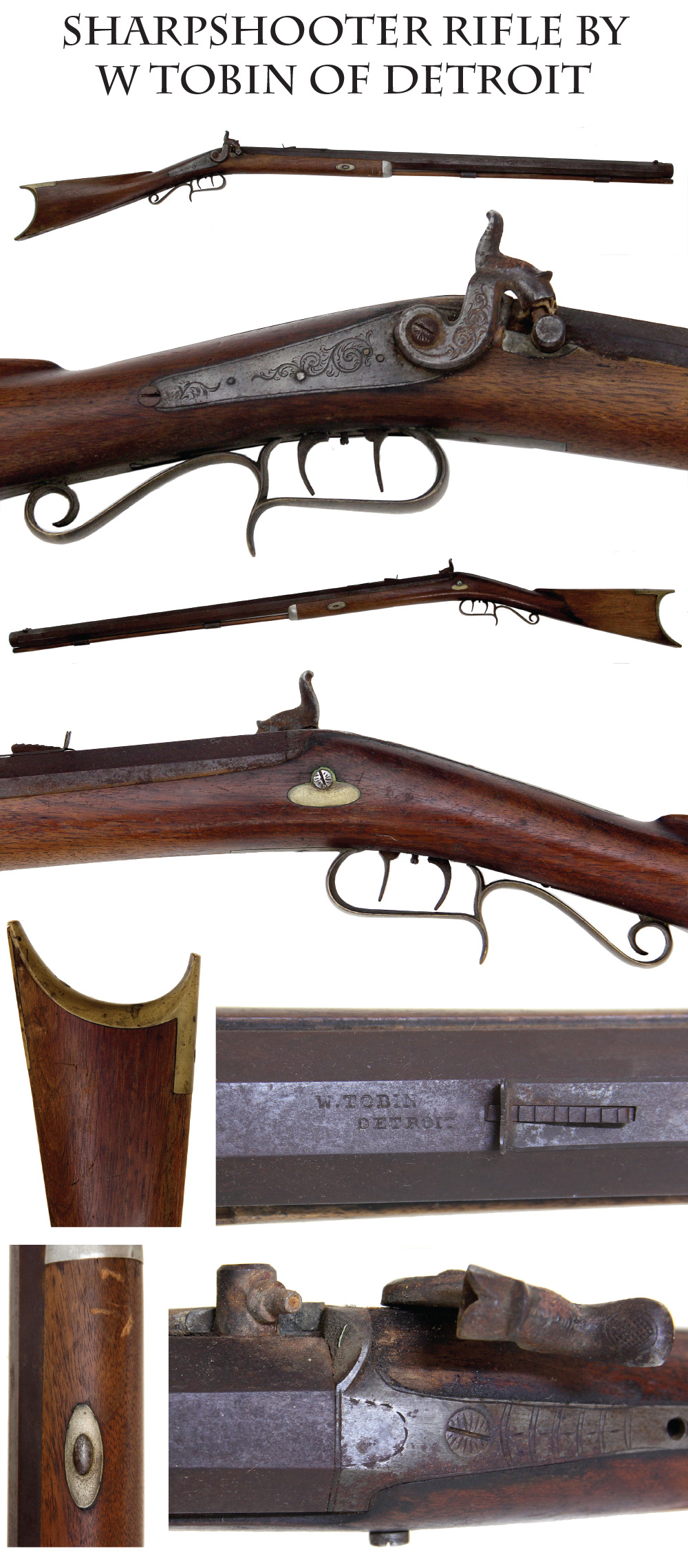
14-10-25 … Target Rifle by William Tobin of Detroit:
Nice half-stock double-set trigger, heavy barrel, target rifle with a back action lock and percussion side lug. Scrolled brass triggerguard and finger rest, deep crescent brass butt plate. Floral scroll engraving on the lockplate and hammer, and the hammer screw is decorated as well. Octagonal heavy barrel still showing lots of blue finish shifting to brown with some light crusty surface rust that would clean with patience and oil. Single lockplate screw on small escutcheon washer on offside, the screw head with decorative notches. Front sight in place, simple buckhorn rear sight with elevation slide, small hole at the tang shows it once also mounted a peep sight of some sort. Wood ramrod seems original. Two ramrod pipes, German silver nose cap, single barrel wedge with oval escutcheon plates. Some rudimentary engraving on breechplug tang and screw. Some crustiness around the nipple and side lug bolster.
Deeply and neatly stamped on the top barrel flat rear of the sight is W. Tobin / Detroit. The 1857 Detroit City Directory lists William Tobin as Gunsmith at 18 Congress Street. I was raised in Detroit and it’s hard to imagine a gunsmith on Congress Street now. Approx 44 caliber with false muzzle stuck in place. I don’t have a small size bore light but I shined a flashlight in it and fear the bore is rusty. Would look great with a hunting bag and horn or flask. Michigan guns are on the scarce side and this is a well made example
… $1,650.00
Click Here to E-mail Us!
Call us @ 419-842-1863

Three fine condition hard rubber whiskey flasks
all nicely marked. Hard rubber was an early form of plastic. It is very fragile and for that reason very few survive in good condition. The interior flask is glass. The exterior covering and removable cup are hard rubber. We have three different sizes….
14-10-26 … 8″ Whiskey Flask “A” …
Whiskey flask with brown, hard rubber covering … with a 2-piece, smooth body including a removable cup and screw-on cap. Top of cap marked
Ind. Rubber Comb Co. Goodyear’s Pat. 1865
. Manufactured between 1865-1872 … 8 inches tall
… $185.00 SOLD
14-10-27 … 7″ Whiskey Flask “B” …
Whiskey flask with brown, hard rubber covering … with a 2-piece, smooth body including a removable cup and screw-on cap. Top of cap marked
Ind. Rubber Comb Co. Goodyear’s Pat. 1865
. Manufactured between 1865-1872 … 7 inches tall
… $175.00 SOLD
14-10-28 … 6″ Whiskey Flask “C” …
Whiskey flask with brown, hard rubber covering … with a 2-piece, smooth body including a removable cup and screw-on cap. Top of cap marked
Ind. Rubber Comb Co. Goodyear’s Pat. 1865
. Manufactured between 1865-1872 … 6 inches tall
… $165.00 SOLD
Click Here to E-mail Us!
Call us @ 419-842-1863
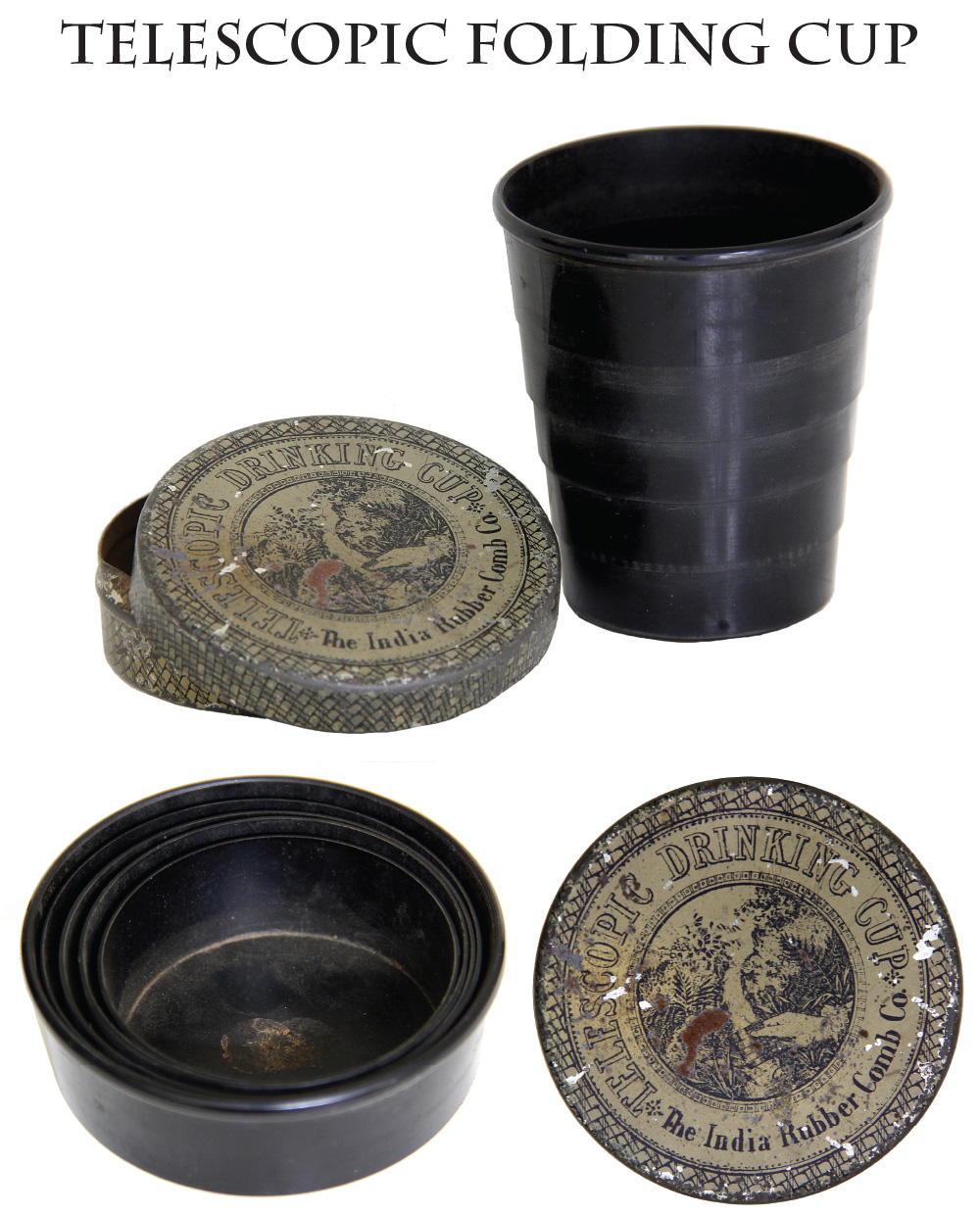
14-10-29 … Hard Rubber Telescopic Drinking Cup & Carrying Tin:
Tin container is 2 5/8″ in diameter with nice label from The India Rubber Comb Company. The cup is 7/8″ contracted, and 2 3/4″ expanded for use. Neat with the tin container.
$135.00 SOLD
Click Here to E-mail Us!
Call us @ 419-842-1863
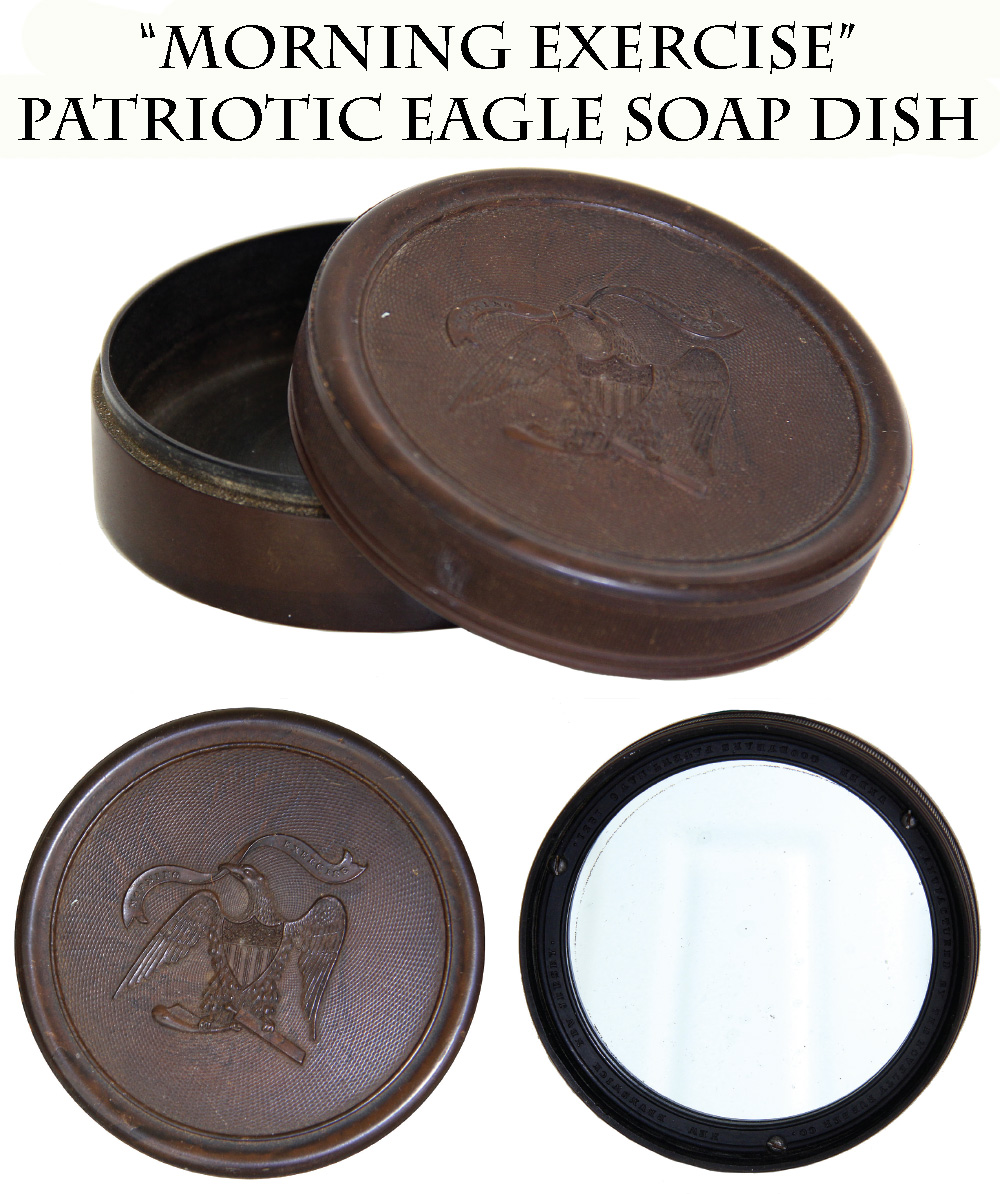
14-10-30 Extremely Rare Army Version Gutta Percha Civil War Shaving Soap Dish & Mirror:
We have all seen the wonderful US Navy versions of these hard rubber soap dishes, but few collectors have seen or even know of the existence of this incredibly rare Army Version. The motif — A ferocious American Eagle, perched and holding a straight razor in one talon and a razor strop in the other. (What a wonderful piece of art!) Clenched in the raptor’s beak is a banner with the marvelous double entendre aphorism “MORNING EXERCISE”. The dish itself is 3.5” in diameter… Cast into the rubber around the mirror is the manufacturer information. “MANUFACTURED BY THE NOVELTY RUBBER CO. UNDER GOOYEAR’S PATENT MAY 6 1851. NEW BRUNSWICK NEW JERSEY”. This is truly a great find and one of only four I have owned. Perfect condition. To accurately stress the rarity of this personal item is difficult. I can say that I have owned many more Confederate Belt rigs than Union army soap dishes. I have owned many more Confederate uniform coats than Union Army Soap Dishes. In other words they are pretty damn scarce. About a hundred times rarer than the navy version. On Nov. 21st, 2008 one of these sold at Heritage Auction for $1,912.00 including the buyer’s premium and that one had a cracked mirror!!! (You can verify this on their web page. Lot 57942 ) I will sell mine at a collector friendly price
… $1,100.00 SOLD
Click Here to E-mail Us!
Call us @ 419-842-1863

14-10-31 … Grape Vine Soap Dish …
Similar to the above, but bearing artistic vine designs in the hard rubber.
3 1/4″ in diameter. Inner lid AND bottom text of outer ring says “MANUFACTURED BY THE NOVELTY RUBBER COMPANY … NEW BRUNSWICK NEW JERSEY … UNDER GOODYEAR PATENT MAY 6, 1851” … The mirror is used, original to the piece and uncracked as far as we can observe. Small ring on outside of lid still present. This is the first “vine design” example I have found. Much scarcer than the navy motif
… $165.00 SOLD
Click Here to E-mail Us!
Call us @ 419-842-1863

14-10-32 … Superb Quality Cased tintype of Michigan Infantryman with his Bowie … Ninth Plate …
Very fine quality thermoplastic case, and that’s not even the best part! Our infantryman tintype is exquisite… truly exceptional! It is crystal clear, razor sharp, vivid, and wonderfully contrasted. He sports his bowie knife, in a “ready for action” pose that showcases his pride in owning such a weapon.
This ninth plate ruby ambrotype is housed in a patriotic The Camp Scene Union case (Krainik-368) under a Union Now and Forever mat, with a period penciled note reading first Mich Infantry / Co. F / Warshington DC.
Also evident are the suspenders holding up his early issue dark color pants and M1858 Hardee hat with infantry bugle.
… $695.00 SOLD
Click Here to E-mail Us!
Call us @ 419-842-1863
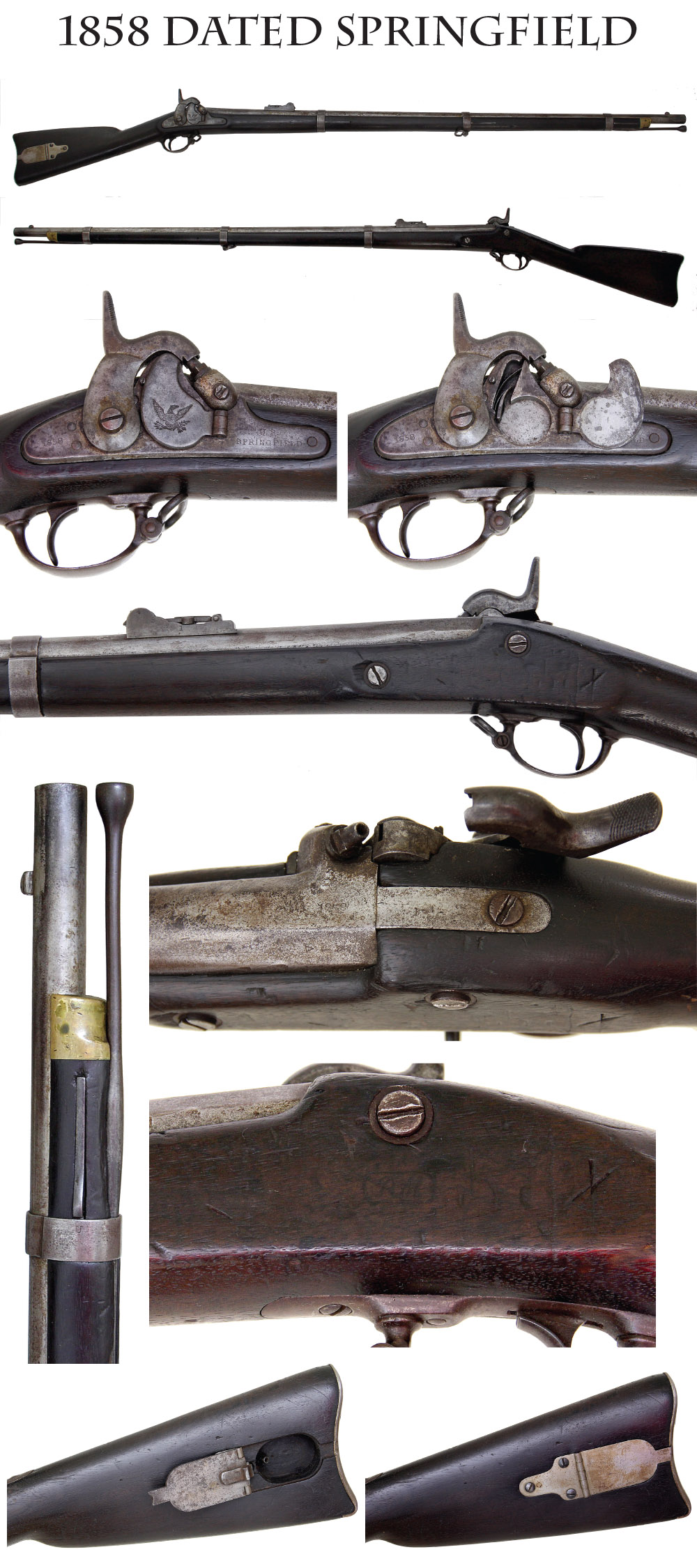
14-10-33 … 1858 Dated Springfield 1855 Model Rifle Musket …
A wonderful true transition model 1855 with features of both first and second patterns. Among the innovations of the 1855 series of US arms was the first general issue to the infantry of a long arm configured like a musket but having a rifled bore. Both Harpers Ferry and Springfield made the weapon, production at Springfield actually getting under way only in 1857. The weapon was .58 caliber, fired the conical minie bullet, and used the Maynard tape primer. This was the regulation infantry arm at the beginning of the Civil War and was the basis for the 1861 pattern rifle muskets that simplified the design by doing away with the patch box and reverting to a simple percussion cap priming system.
Our example is from the second year of production and has a clear 1858 lock plate date with the correct eagle on the primer door and US over Springfield forward of the hammer. The barrel shows the V/P/Eagle proofs and a matching 1858 barrel date that is a bit rubbed but legible. Ours mounts the 1855 pattern long range rear sight, which is a “Type I” feature, as well as the brass nose cap, also a Type I feature. The hammer shows the notch at its nose, introduced in 1858 to cut the primer strip when it strikes the nipple. It is likely this weapon was produced in the second half of the year, since it also has the patch box in the butt stock, which was formally adopted for rifle muskets in 1859, and is considered a feature of the “Type 2” muskets. What makes this an indisputable “transition model” is the presence of both the brass nose cap (type1) and the steel patch box (type 2) on the same stock. The primer mechanism works and the mechanics are good. All swivels, bands, and sights are in place, as is the original ramrod. These guns were issued “in the bright” and our barrel and furniture are a light gray with darker gray areas mixed in, no serious corrosion other than some light salt and peppering near the breech from actual firing. The lockplate, hammer, and primer door show a bit more gray and darker areas with a couple of brown spots. Hammer screw slot is good, clean out screw shows a bit of wear. Wood is dark and generally very good, showing at least one cartouche on the offside, though with some scattered minor dings and what might be a small X carved at the rear of the wrist, or just two shallow grooves that meet, and a small divot or chip out at the edge of the forward lock screw. Butt plate and primer door match the rest of the metal in color. The patch box screws show some color. The nose cap has a nice mellow patina to the brass. Very good bore. Cartouche appears to read “B H” which would be Major Benjamin Huger (later General Confederate States Army). Huger conducted tests on experimental rifles at Harpers Ferry in 1853, and at both Harpers Ferrry and Springfield in 1855. He is known to have inspected arms from at least 1854 to 1858, resigning his US commission at the outbreak of the Civil War and accepting a commission in the CSA. This is a key US long arm for a gun collector and a wonderful true “transition” model for the advanced collector. It is proper for display with US or CS equipment. A very solid specimen … bcjj
… $2,850.00 SOLD
Click Here to E-mail Us!
Call us @ 419-842-1863

14-09-34 … Civil War .58 Caliber US Socket Bayonet …
The standard Civil War bayonet for all the US .58 caliber rifle muskets. Full length, functional locking ring, light US stamp at the base with a maker or inspector initial “S” below it and a rack number “49” above. Blade is bright, moving to gray toward the socket. A basic weapon for the Civil War collector and a nice addition to a rifle musket. Fits all M1855 .. M1861 .. M1863 rifle muskets … bjj
… $165.00 SOLD
Click Here to E-mail Us!
Call us @ 419-842-1863

14-10-35 … Large Frame Allen and Thurber Sidehammer Rifled Screw Barrel Pistol:
Made in the late 1840s and early 1850s in limited quantity, probably only a few hundred. This is a large and elegant pistol. 8 inch Barrel is part round, part octagon, houses a wood rammer in two thimbles. Looks like 32 or 36 caliber. Nice condition wood bag style grips fastened with two screws. The trigger guard has a spur for a surer grip and better accuracy. Barrel marking on side flat: “Allen & Thurber Worcester” followed by “Cast Steel.” The standard rear sight extended to the rear of the hammer and had an adjusting screw. This one was modified by the owner with a brass blade front sight and fixed block sight at the rear. Metal has some very minor dings and light peppering at the nipple, otherwise smooth gray with some scattered dark spots and traces of color near the breech. A nice American single shot percussion pistol by a very well known maker. These are sometimes referred to as “pocket rifles” due to the long barrels … ycge
… $550.00 SOLD
Click Here to E-mail Us!
Call us @ 419-842-1863

14-10-36 … Single Shot Percussion Boot Pistol …
These imported little percussion pistols were the “Saturday Night Specials” of their day: inexpensive and easily concealed in vest or boot top for self-defense or mischief. This one has a four inch octagonal barrel (40-odd caliber) and simple bag shaped wood grips. There is a small “0” stamped several times on the gun that is likely an assembly mark. The company name is stamped in an oval beneath the nipple reading “E & Cie” or perhaps “B & Cie,” the latter being the French abbreviation for Compagnie. Mechanically functional, wood decent, metal shows staining and dings, but also striations on barrel showing it originally had a nice finish imitating a Damascus twist. A nice early western back up weapon. Not a few probably made their way into Civil War camps to be confiscated by officers not wanting their recruits shooting one another … abe
… $195.00 SOLD
Click Here to E-mail Us!
Call us @ 419-842-1863
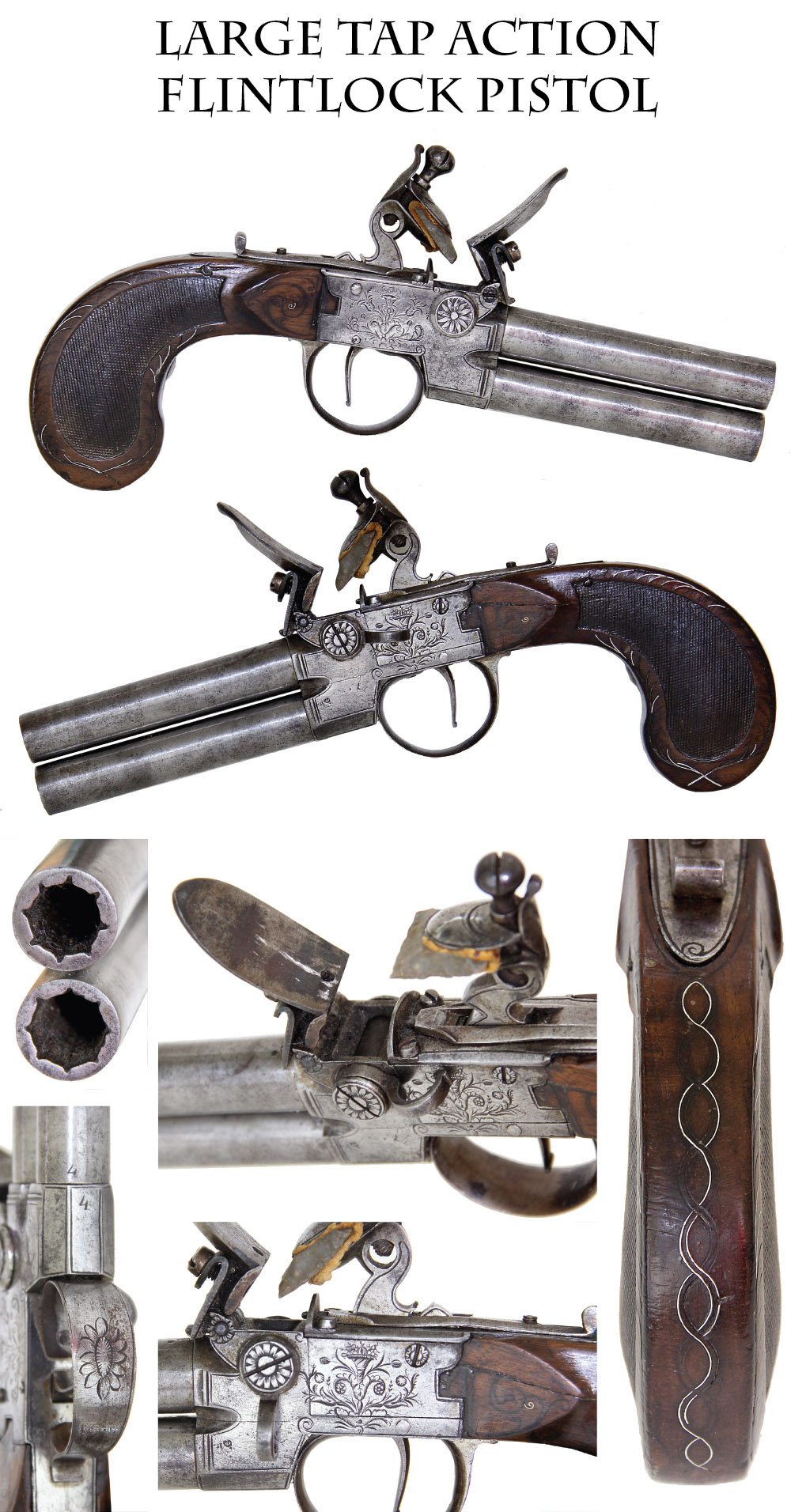
14-10-37 … Elegant Large Size Tap Action / Over and Under / Flintlock Pistol …
These double barrel pistols have rifled bores and packed a good wallop close up. The barrels screw off for loading, which enables a close fitting ball to be used. A little lever on the side acted as a firing selector for the barrels, operating as a barrel tap to open and close either section of priming powder so the gun could be fired, then cocked and fired a second time. A simple, effective sliding safety bar along the top acts to secure the hammer until needed. This is an elegant little gun. The grips are checkered and wire inlaid, the receiver is engraved with floral motifs, as are the screws. Approx 44 caliber. Four inch barrels. Nine inches overall. Small sections of the wire inlay are missing, and there is an old crack and small repair to the wood at the rear of the receiver, which is not very noticeable. The metal has a pleasing smoky patina, with faint hints of color on the barrels. No maker marks, but certainly a British made weapon of the late 18th, early 19th century. These are more commonly seen in small pocket sizes with two or three inch barrels. This is a dandy early pistol in the much rarer large size … ijj
… $1,250.00 SOLD
Click Here to E-mail Us!
Call us @ 419-842-1863
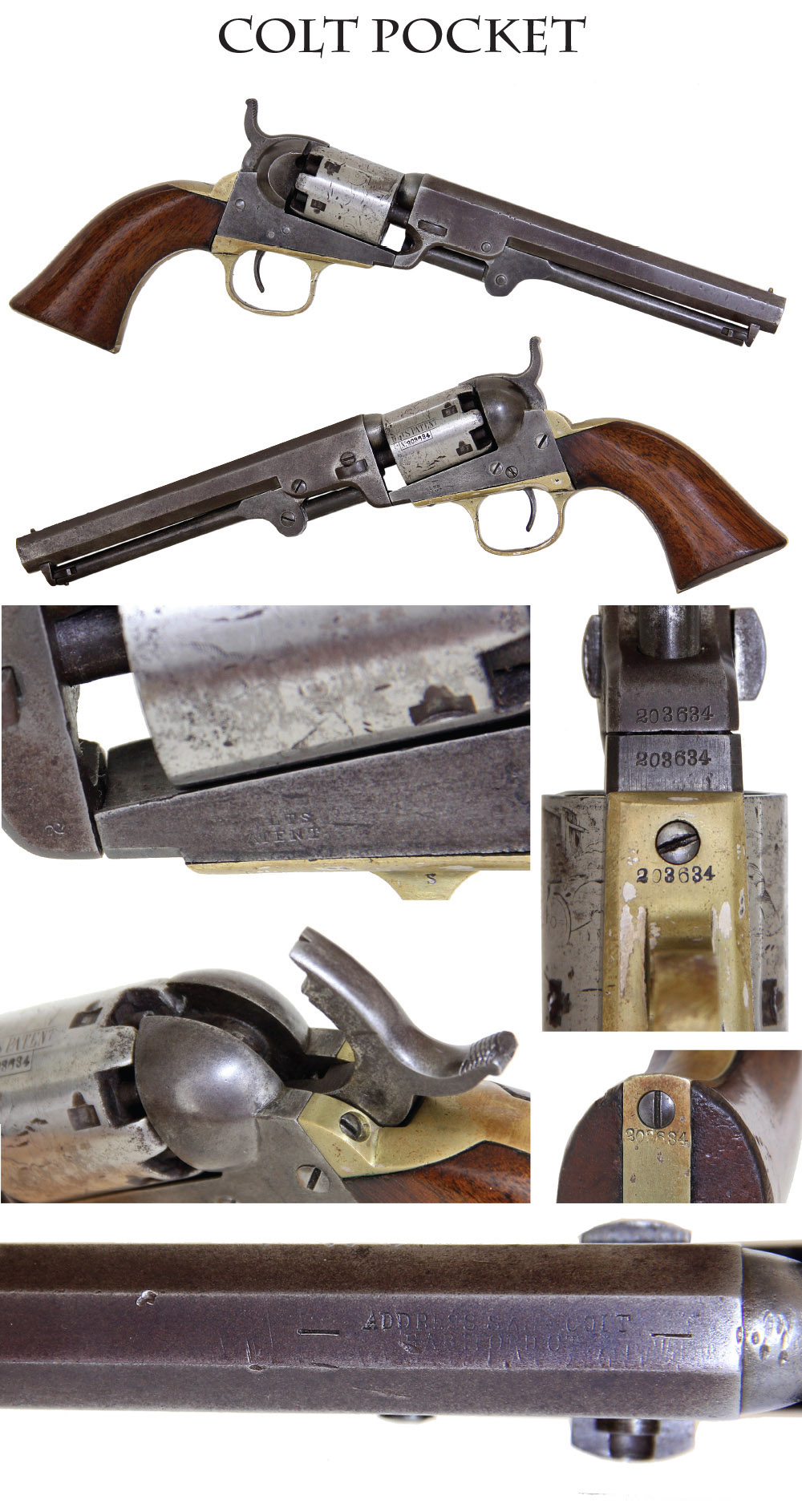
14-10-38 … Six Inch Colt Pocket Revolver:
Nice example of one of Colt s best looking guns, the 1849 Pocket Revolver. Excellent grips, tight wood to metal fit. The barrel legend is a two line Hartford type showing light wear. Colts Patent on the frame visible and a bit light on the right edge. Matching serial numbers 203634 throughout, giving good Civil War date of 1862 for the year of manufacture. Barrel, loading assembly and frame show a matching even smoky plum patina from faded blue and case colors. The cylinder shows over cleaning with a brighter tone and some loss of detail in the cylinder scene, though much of it is visible. (Note: over cleaned cylinders are the result nit-wit collectors trying to “clean” their gun. The cylinder being perfectly cylindrical, was therefore the easiest part for a nit-wit gun collector to over polish using crocus cloth. Thank goodness most of today’s collectors know better.) The Colts Patent marking and serial number are still very clear on the cylinder. Screw slots are good, mechanics good. Metal smooth overall, some minor dings at forcing cone of barrel and front edge of cylinder at the Colts Patent stamp, some nicer color on rear of recoil shield and lower part of frame. These .31 caliber pistols were favorites of officers who needed a side arm but did not want to lug around a belt size revolver. The proportions of the gun make it very pleasing, and there are enough variations in its manufacture that a couple of books have been written about it and it is a collecting field of its own. It came in several barrel lengths. The six-inch is the best proportioned … fzx
… $950.00 SOLD
Click Here to E-mail Us!
Call us @ 419-842-1863
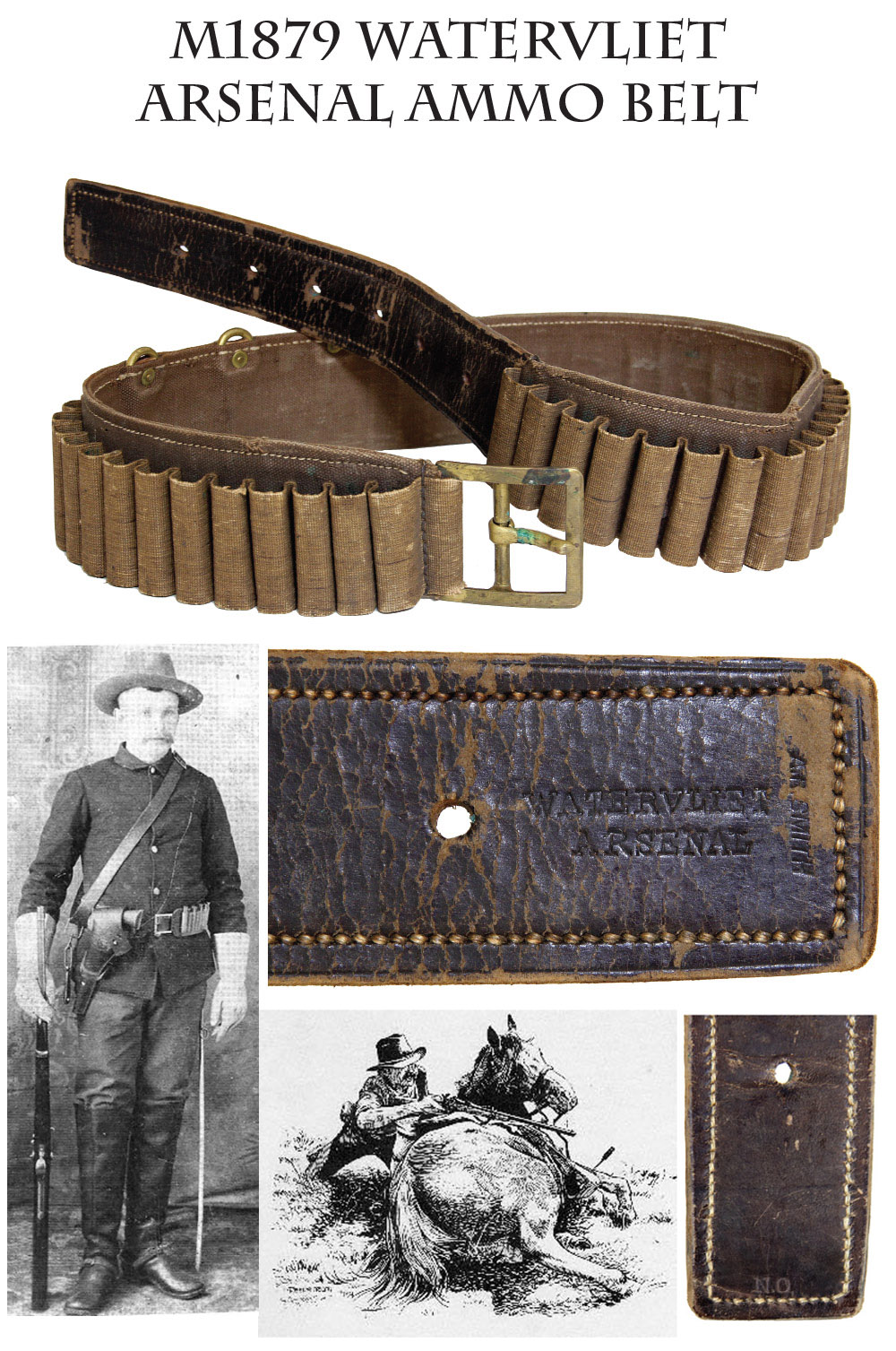
14-10-39
… Indian Wars M1876 Linen Prairie Belt in Excellent+ Condition, w/ 1879 Upgrade – Watervliet Arsenal Markings & A.R. Smith Inspection Stamp:
Very Scarce Indian Wars M1876 Linen Prairie Belt (un cut) with 1879 modification of addition of 3 brass loops. Exc Cond. Watervliet Arsenal marked and A.R. Smith Inspected. Superb find for display with early Indian War US Springfield carbine before adoption of the Mills woven belt in 1880. Excellent Overall Condition. Full length, unaltered. Priced well below my competition
… $650.00 SOLD
Click Here to E-mail Us!
Call us @ 419-842-1863
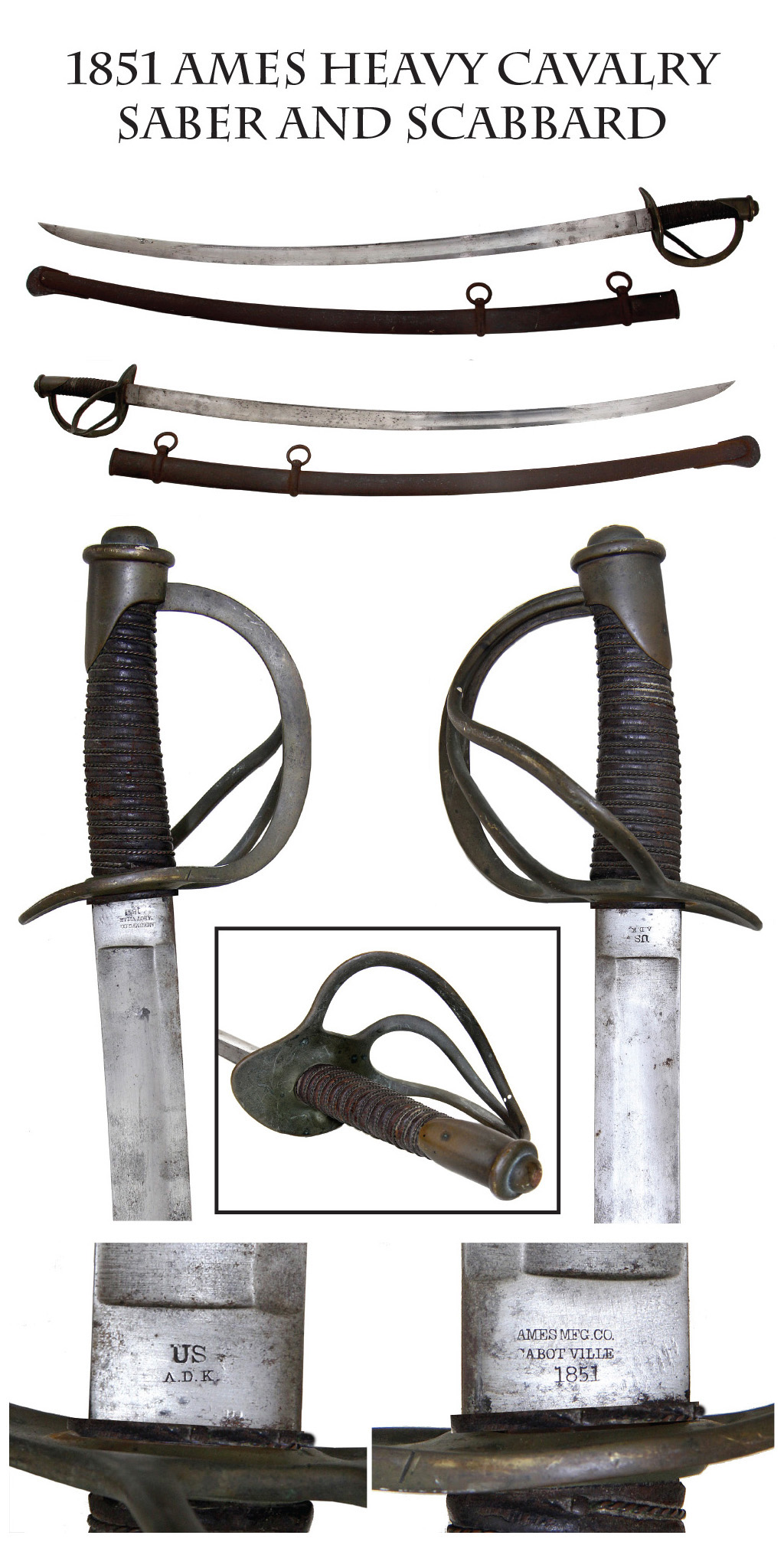
14-10-40 … M1840, 1851 Dated Ames Heavy Cavalry Saber and Scabbard …
M1840 Heavy Cavalry Saber, marked “AMES MFG. CO. / CABOTVILLE /1851” and “US / A.D.K.” … this “wristbreaker” saber and scabbard are both in VG to FINE condition. The blade is without bends, nick free, and has a pleasing aged steel patina. The leather grip has dried out a touch, but looks great, and is in Fine condition with original wire wrapping. The guard is likewise in fine condition as well, with only modest handling wear for its age, and a light patina. The scabbard is likewise in very good condition with a smooth dark brown patina, and no damage or defects of significance. … gejyy
… $1,250.00
Click Here to E-mail Us!
Call us @ 419-842-1863
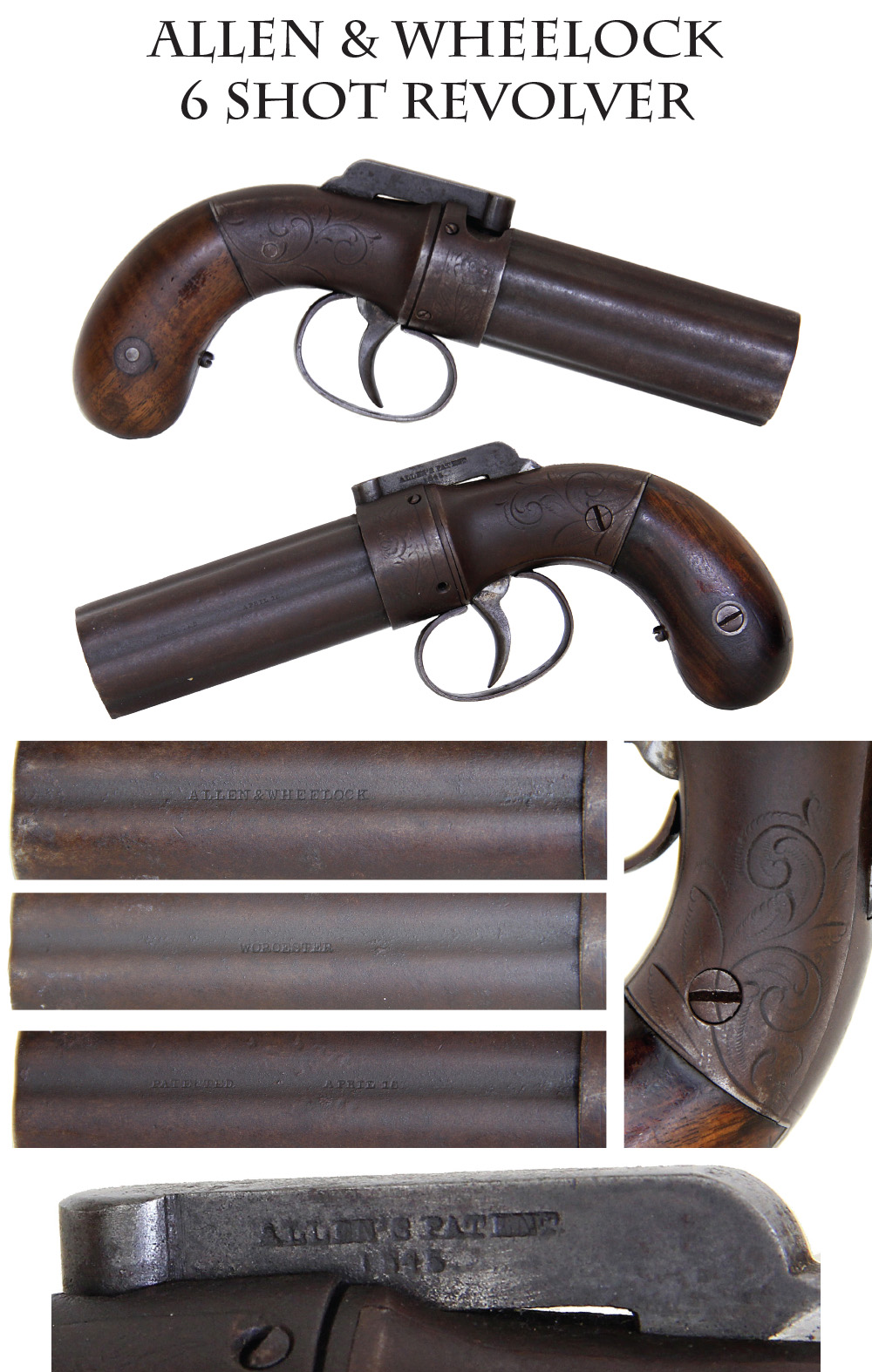
14-10-41 … Allen & Wheelock 6 Shot Revolver …
Allen’s Patent Pepperbox – This 6 shot pepperbox was made by Allen & Wheelock. in Worcester Mass. Circa 1840s to 1850s. It has a 4 inch barrel. The bar hammer is marked “ALLEN’S PATENT 1845” on the side, and the barrel is marked “ALLEN & WHEELOCK” “WORCESTER” “PATENTED APRIL 16” … This gun is a standard medium size and has the evenly curved bag shaped round handle, an engraved frame and nipple shield, and fluted barrels. Overall good condition with rich traces of original blue finish in protected areas. Much nicer than many we find. These pepperbox pistols are great conversation starters when a neighbor comes to view your collection… dyy
… $575.00 SOLD
Click Here to E-mail Us!
Call us @ 419-842-1863

14-10-42 … J.B. Boylan Contract Civil War Heavy Artillery Enlistedman’s Frockcoat …
Very nice example of the regulation private’s frock coat for heavy artillerymen. Trained to handle the big guns of forts and also drilled to act as infantry, many of these regiments were called into the field for Grant’s overland campaign in the Spring of 1864 and saw heavy action. In fact, the First Maine Heavy Artillery lost more men killed in a single battle than any other regiment in the war: 7 officers and 108 enlistedmen killed, and hundreds more wounded in a charge at Petersburg in June, 1864. It’s wartime loss was also among the highest: 423 in killed alone.
John Boylan had been a clothier since the 1840s and had a large number of contracts with the Federal government for greatcoats, sack coats, VRC jackets, zouave jackets, infantry and cavalry trousers, and lots of other garments. This is an example of his heavy artillery frocks and is prominently marked in the sleeve: “1 / J.B. BOYLAN, Newark, NJ / Contract Nov. 3d. 1864” along with a second size number “1” to the left.
This is a darn nice coat: very solid with few moth tracks or nips, sleeve, body and pocket linings all fully in place. The collar lining could use a few stitches on the left bottom corner where the small hook to fasten the collar closed apparently pulled out, and about an inch along the bottom interior edge at the lining. The small loop on the left collar edge is in place. The right cuff is missing the lower eagle button and has a small moth nip next to the upper one; the left cuff has two or three pencil point nips near the cuff. All piping is in place and tight on collar and cuffs. Skirts are full length and unhemmed as is correct. A fold line along the bottom shows it may have been tucked up at one time. Both large waist buttons at rear are in place. All nine are in place on the front. All are unmarked. A small fingernail size moth bite on the left skirt panel below the button has been neatly backed as also has one on the central fold just next to it. Skirt pockets are intact and tight. Buttons are unmarked.
This is a scarce coat and one that would be almost impossible to improve upon for condition and markings. Color of coat and piping is vibrant and it is a showy piece of Civil War cloth
… $7,950.00
Click Here to E-mail Us!
Call us @ 419-842-1863
Layaways are Welcome
Need to split your order into multiple payments? No problem! A simple 20% earnest money deposit will hold your item for you.-acf
You can then pay it off in easy installments that fit your budget.
Read Terms Here
Items to Sell? Contact Us
I am always interested in buying ANYTHING from the American Civil War… Guns, Swords, Civil War Muskets, Knives, Uniforms, Flags, Medals, Badges, Diaries, Letters, Autographs, Buttons, photographs, tintypes, daguerreotypes, Insignia, Camp Items, Battlefield Relics, canteens, Drums, Etc… Call 419-842-1863 and ask for Dave Taylor.

